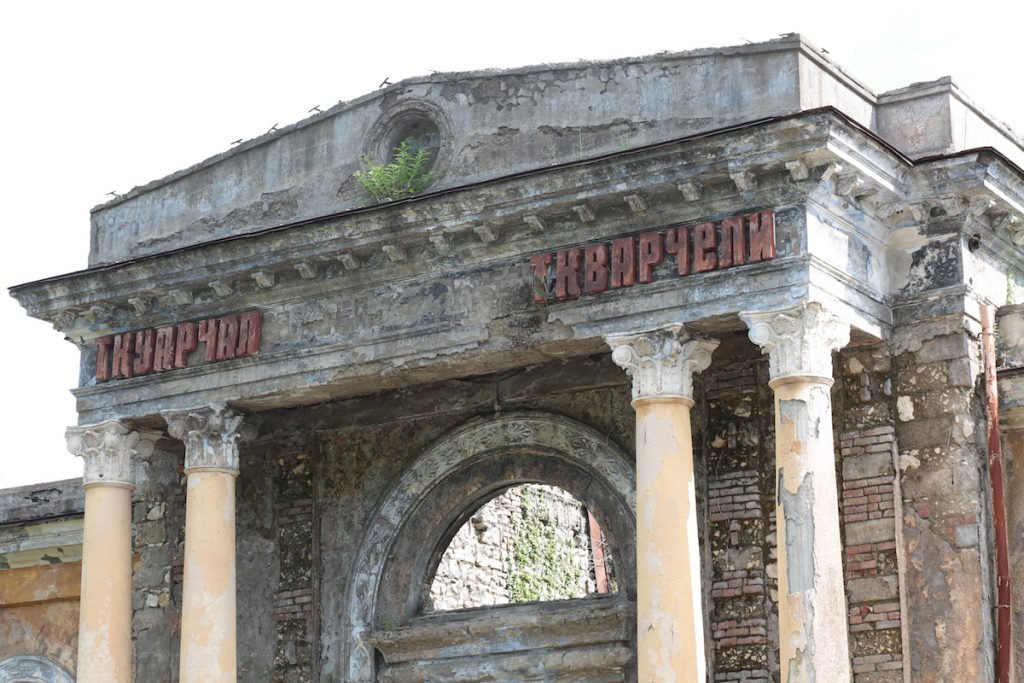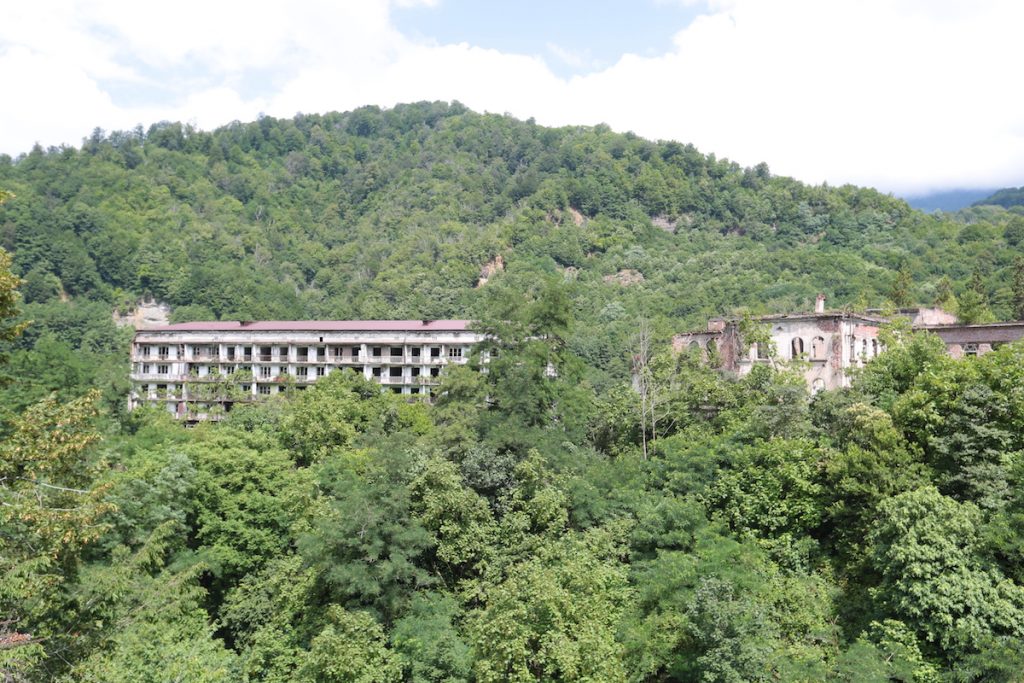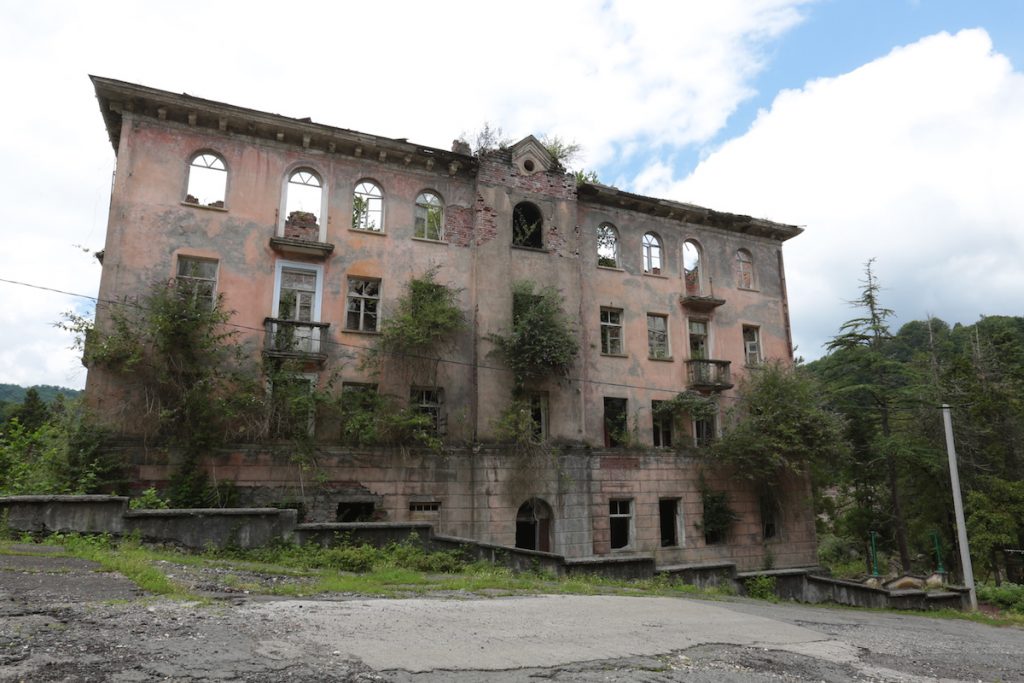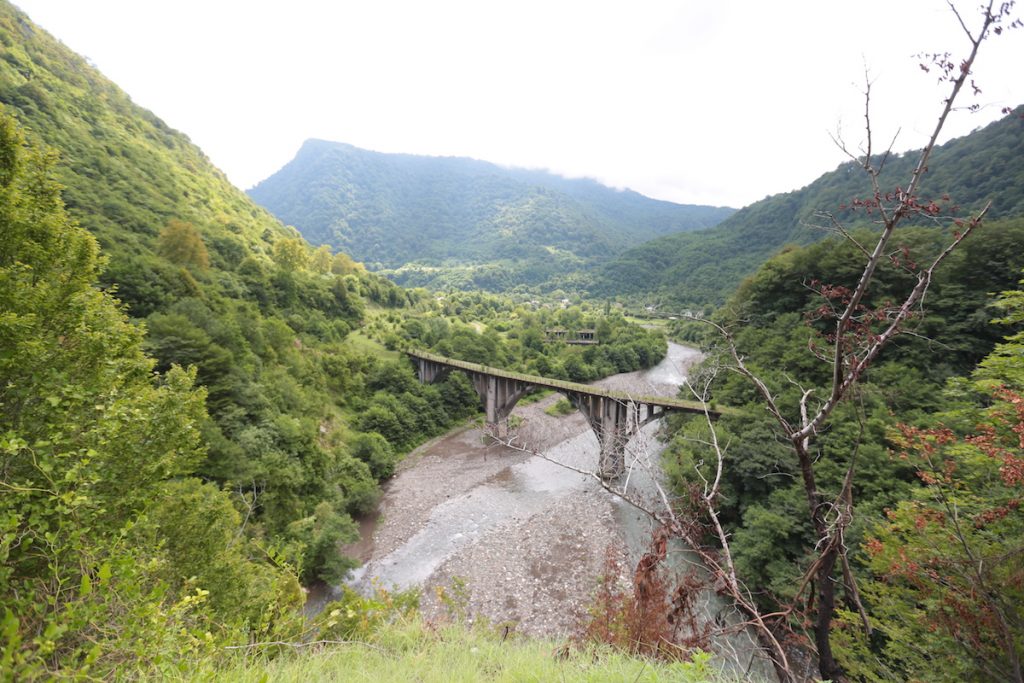Tkuarchal, Abkhazia – a former coal capital trying to survive - JAMnews (original) (raw)
The mining town of Tkuarchal in Abkhazia is slowly dying. The mines have been closed for a long time, there is practically no other work. Most of the locals have left. For those who remain, hopes to survive are connected only with tourism, for the development of which little has been done so far.
• Where are all the Abkhaz anchovies going?
• [Куда плывет абхазская хамса?](http://Op-ed: difficult times ahead for the economy of Abkhazia)
City and war
Traces of the 1992-93 Georgian-Abkhaz war are everywhere here. As soon as you enter the city, and it starts from the industrial zone, on both sides of the road, evoking sadness and despondency, there are the skeletons of destroyed enterprises, sometimes wrapped in abundant subtropical vegetation. Against their background, a newly painted “gold” statue to the miner is a monument to the foregone Soviet industrial power of Tkuarchal.
Monument to a miner in the city of Tkuarchal, Abkhazia. Photo: Ibrahim Chkadua, JAMnews
Throughout the Georgian-Abkhaz war, the city was under blockade.
“There were Georgian troops in front, which constantly fired at Tkuarchal, behind the mountain. Almost no food. Only occasionally food was delivered from the ‘mainland’ by helicopter. But naturally, it was not enough. People shared what they had”, says Ibrahim, a gas filler.
During the war, he was in the local militia. “I remember one period, of food at home we had only honey and nothing else. Honey for breakfast, honey for lunch, honey for dinner … At times in this position I thought more about food than about the enemy’s bullet. The constant feeling of hunger is what I associate with the time of blockade”.
The memories of the people of Tkuarchal have long been divided into the periods of what happened to the city in Soviet times, during the Georgian-Abkhaz war and what is now.
Former building in the city of Tkuarchal, Abkhazia. Photo: Ibrahim Chkadua, JAMnews
Former greatness
Tkuarchal is the only city in Abkhazia that is not located in a coastal zone. It is completely ringed by mountains, and only one road, including the railway, leads to the entrance and exit. At the end of the twenties of the last century, large deposits of coal were discovered here.
In the Soviet Union at that time, industrialization was going on throughout, so the country’s leadership did not delay industrial development. Within a short time, several mines and processing enterprises were opened in this mountainous area, a railway was built along which Tkuarchal coal was transported. Mainly high-quality anthracite was mined, without which the work of metallurgical plants was impossible.
The city of Tkuarchal, Abkhazia. Photo: Ibrahim Chkadua, JAMnews
During World War II, the significance of the Tkuarchal coal for the country increased sharply.
“When the Germans occupied Donbass, the whole burden of supplying coal to industrial enterprises in the rear of the entire south of the country, as well as the Black Sea Fleet, fell on our mines.
That is why in 1942, in the midst of the war, when the enemy was looming over the Greater Caucasus Range, and was about to invade Abkhazia, our Tkuarchal, and then it was called Tkvarcheli, received the status of a city,” says the history teacher of the local school Dmitry Shoua.
Most of the administrative and public buildings, as well as residential buildings in the central part of Tkuarchal, were built by captured German soldiers at the end of the war and in the early post-war years. German architects and engineers participated in the design of the buildings.
The Gothic style combined with the Stalinist Empire style made Tkuarchal different from all other small towns.
Building in the city of Tkuarchal, Abkhazia. Photo: Ibrahim Chkadua, JAMnews
Not only Tkuarchal, but also the nearby mining villages – Akarmara, Dzhantukh, Polyana, were also soundly rebuilt.
The population of Tkuarchala in Soviet times was about 30,000 people. Plus, two to three thousand people lived in each of the adjacent mining villages.
“In Dzhantukha we had all the necessary infrastructure – a cinema, shops, including a bookstore. There was a hairdresser, a savings bank, a dry cleaner. There was even a police station,” Ibrahim recalls. The shops were well-stocked. People came here from Sukhum and Gagra for the scarce goods. The miner’s profession in the Soviet Union was then held in high esteem.”
Decline
Today, the city’s former greatness and attention is perceived as a sweet dream.
In the late eighties, with the decline of the Soviet economy, a gradual outflow of the population of Tkuarchal began. And after the Georgian-Abkhaz war, it became widespread.
Building in the city of Tkuarchal, Abkhazia. Photo: Ibrahim Chkadua, JAMnews
Today, no more than 5,000 people live in the town. Lack of work is Tkuarchal’s main problem. The coal mines are abandoned. In the 2000s, a Turkish company started mining coal as a quarry, but for five years already, due to the economic crisis, it had to curtail its activities.
Of the several factories that worked in the city during the Soviet era, only one is functioning, and then in an extremely limited mode – there is a workshop for the production of Abkhaz state awards.
Periodically, the Abkhaz authorities try to stop the outflow of the population. The House of Culture and the sports and recreation complex were repaired, and the construction of the hospital is now being completed.
Even a swimming pool was planned, but there was not enough money for the project, and the construction has been frozen for ten years.
The city has its own theater. It was created by an amateur, but not so long ago, its status was raised and it became a state theater. The troupe is small – only fourteen actors. Director Roman Sabua laments the staffing problem:
“We have a shortage of men. Local guys do not want to be actors, they are shy, and a visiting actor cannot be lured here for a small salary. So when choosing a performance, you have to take into account the realities of personnel.”
Dzhantukh village – several entrances per family
While the Abkhaz authorities still somehow have enough resources to support Tkuarchal, they do not have them at all for the mining villages.
“This is my house, and that one is Kolya Sinyakov’s. True, his house has only two entrances, and I have three,” jokes local Vova Bargandzhia, pointing at the empty window panes.
Vova Bargandzhia is one of the last residents of the mining village of Dzhantukh, Abkhazia. Photo: Ibrahim Chkadua, JAMnews
Vova’s house was built in the Gothic style by German prisoners of war. It is built soundly from hewn stone. The walls are almost a meter thick. According to him, it can stand for several centuries “if the roof does not fail.”
Periodically, he patches the roof, but cosmetic repairs alone are no longer enough. The roof is completely leaky and requires a major replacement.
“I have a closet in this apartment. Once upon a time our teacher Vera Pavlovna lived here. And I use this apartment for guests”, Vova says, conducting a tour of his ‘rooms.’ “None of the apartments in the village are key-locked – there is no need. People live very poorly, besides there are very few of them.”
There are only eight families left in Dzhantukha. If everything goes as it is now, then in ten years there will be no one left in the village. There is absolutely no infrastructure here. There is no school, no first-aid post, not even a seedy kiosk. For bread, one has to drive along the bumpy road to Tkuarchal. And that’s ten kilometers away.
Vova Bargandzhia works as a guard at the administrative building of the closed Turkish coal mining company. His salary is 15,000 rubles. He says that he was lucky.
Other residents of the village mainly live on subsistence farming. Almost all are hunters. You don’t have to go far for prey – wild boars and bears sometimes come here themselves
**Ruins – a tourism engine?
The local population hopes to preserve Tkuarchal and its villages are no longer associated with the reanimation of industry, but with tourism. In recent years, this region has been promoted by Russian bloggers. Many of them are delighted with the assortment of abandoned palaces and factory ruins drowned in greenery.
In addition, there are beautiful waterfalls and gorges that serve as an additional attraction for Russian tourists. The mass of photos and videos replicated on the Internet became virtually free advertising for Tkuarchal.
Neighborhoods of the city of Tkuarchal, Abkhazia. Photo: Ibrahim Chkadua, JAMnews
The flow of tourists to the region, of course, is not comparable with how many of them come to the famous Abkhaz resorts of Gagra and Pitsunda – there is only one mini-hotel and several excursion groups a day – but for the Tkuarchal residents who are not spoiled by this kind of attention, this is already something.
“In a day, it happens that a hundred cars with tourists pass here. They will definitely stop and buy honey or dogwood compote,” says Nonna Berzenia about the scale of tourist interest. Her small stand selling twists (homemade canned food in glass jars) is the only one in the area.
It is located in the village of Akarmara at a fork in the road leading to two waterfalls. Nonna has three daughters. They are all married and live in Sukhum. They periodically visit their mother, who does not want to go anywhere. For she believes that sooner or later life will improve here.





